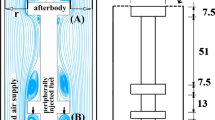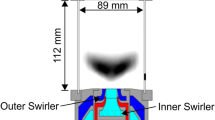Abstract
This paper discusses the final investigation into the effect of fuel stratification on flame propagation. In previous works, the characteristics under the no port-generated swirl condition and the low-swirl condition were considered. For this purpose, the initial flame development and propagation were visualized under different axially stratified states in a modified optical single-cylinder SI engine. The images were captured by an intensified CCD camera through the quartz window mounted in the piston. Stratification was controlled by the combination of the port swirl ratio and injection timing. These were averaged and processed to characterize the flame propagation. The flame stability was estimated by the weighted average of flame area and luminosity. The stability was also evaluated through the standard deviation of flame area and propagation distance and through the mean absolute deviation of the propagation direction. The results show that the LML is expanded remarkably under the high-swirl cases up to the highest relative AFRs of 1.71 and 1.75 between 140 and 160CA. In addition, similar to the low-swirl condition, the flame-flow interaction determines the direction of flame propagation, and the governing roles of the two factors vary according to the swirl level; the flow is more important at the higher swirl conditions, and the flame is more important at the lower swirl condition. Finally, fast and stable flame propagation can be achieved under the preferably stratified condition, which is induced by the suitable combination of the high swirl and injection timing.
Similar content being viewed by others
References
Ando, H. and Akishino, K. (1991). Concept of lean combustion by barrel-stratification. SAE Paper No. 912207.
Heywood, J. B. (1988). Internal Combustion Engine Fundamentals. MacGraw-Hill. New York. 371–375.
Horie, K. (1992). The Development of high fuel economy and high performance four-valve lean burn engine. SAE Paper No. 920455.
Matsushita, S. (1985a). Development of the Toyota lean combustion system. SAE Paper No. 850044.
Matsusita, S. (1985b). Effects of helical port with swirl control valve on the combustion and performance of SI engine. SAE Paper No. 850046.
Ohm, I. Y. and Cho, Y. S. (2001a). In-cylinder fuel behavior according to fuel injection timing and port characteristics in an SI engine: Part I-Without swirl. Trans. Korean Society of Automotive Engineers 9,2, 19–27.
Ohm, I. Y. and Cho, Y. S. (2001b). In-cylinder fuel behavior according to fuel injection timing and port characteristics in an SI engine: Part II-With low/medium swirl. Trans. Korean Society of Automotive Engineers 9,3, 9–17.
Ohm, I. Y. and Cho, Y. S. (2001c). In-cylinder fuel behavior according to fuel injection timing and port characteristics in an SI engine: Part III-With high swirl. Trans. Korean Society of Automotive Engineers 9,3, 18–26.
Ohm, I. Y. and Park, C. J. (2002). Experimental study on axial stratification process and its effects (1). Int. J. Korea Society of Mechanical Engineers 16,11, 1457–1469.
Ohm, I. Y. and Park, C. J. (2006a). Effect of fuel stratification on initial flame development: Part 1-Without swirl. Int. J. Automotive Technology 7,5, 519–526.
Ohm, I. Y. and Park, C. J. (2006b). In-cylinder intake flow characteristics according to inlet valve angle. Trans. Korea Society of Automotive Engineers 14,3, 142–149.
Ohm, I. Y. and Park, C. J. (2006c). In-cylinder compression flow characteristics according to inlet valve angle. Trans. Korean Society of Automotive Engineers 14,4, 77–83.
Ohm, I. Y. and Park, C. J. (2008a). Effect of fuel stratification on initial flame development: Part II-Low swirl condition. Int. J. Automotive Technology 9,6, 671–678.
Ohm, I. Y. and Park, C. J. (2008b). Effect of inlet valve angle on in-cylinder swirl generation characteristics (I). Trans. Korean Society of Automotive Engineers 16,6, 148–156.
Ohm, I. Y. and Park, C. J. (2009). Effect of inlet valve angle on in-cylinder swirl generation characteristics (II). Trans. Korean Society of Automotive Engineers 17,2, 42–48.
Ohm, I. Y., Ahn, H. S., Lee, W. J., Kim, W. T., Park, S. S. and Lee, D. U. (1994). Development of HMC axially stratified lean combustion engine. 1993 SAE Trans. 103,3, 1298–1311.
Ohm, I. Y., Jeong, K. S. and Jeung, I. S. (1998). Effects of injection timing on the lean misfire limit in an SI engine. 1997 SAE Trans. 106,3, 42–55.
Quader, A. A. (1982). The axially-stratified-charge engine. SAE Paper No. 820131.
Stone, R. (1992). Introduction to Internal Combustion Engines. 2nd Edn. MacMillan. London. 72–74.
Takeda, K. (1985). Toyota central injection (CI) system for lean combustion and high transient response. SAE Paper No. 851675.
Author information
Authors and Affiliations
Corresponding author
Rights and permissions
About this article
Cite this article
Ohm, I.Y., Park, C.J. Effect of fuel stratification on initial flame development: Part 3-high swirl condition. Int.J Automot. Technol. 12, 653–660 (2011). https://doi.org/10.1007/s12239-011-0076-y
Received:
Revised:
Published:
Issue Date:
DOI: https://doi.org/10.1007/s12239-011-0076-y




